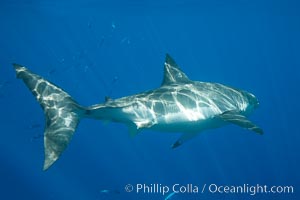
A great white shark swims away, showing its powerful caudal fin (tail), short anal fins on its underside, tall dorsal fin on top and sweeping winglike pectoral fins.
Species: Great white shark, Carcharodon carcharias
Location: Guadalupe Island (Isla Guadalupe), Baja California, Mexico
Image ID: 19466
Species: Great white shark, Carcharodon carcharias
Location: Guadalupe Island (Isla Guadalupe), Baja California, Mexico
Image ID: 19466
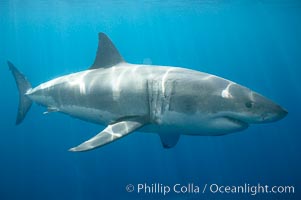
A great white shark is countershaded, with a dark gray dorsal color and light gray to white underside, making it more difficult for the shark's prey to see it as approaches from above or below in the water column. The particular undulations of the countershading line along its side, where gray meets white, is unique to each shark and helps researchers to identify individual sharks in capture-recapture studies. Guadalupe Island is host to a relatively large population of great white sharks who, through a history of video and photographs showing their countershading lines, are the subject of an ongoing study of shark behaviour, migration and population size.
Species: Great white shark, Carcharodon carcharias
Location: Guadalupe Island (Isla Guadalupe), Baja California, Mexico
Image ID: 19467
Species: Great white shark, Carcharodon carcharias
Location: Guadalupe Island (Isla Guadalupe), Baja California, Mexico
Image ID: 19467
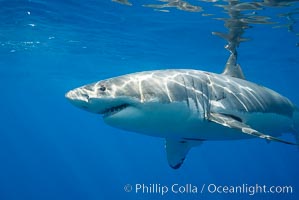
A great white shark is countershaded, with a dark gray dorsal color and light gray to white underside, making it more difficult for the shark's prey to see it as approaches from above or below in the water column. The particular undulations of the countershading line along its side, where gray meets white, is unique to each shark and helps researchers to identify individual sharks in capture-recapture studies. Guadalupe Island is host to a relatively large population of great white sharks who, through a history of video and photographs showing their countershading lines, are the subject of an ongoing study of shark behaviour, migration and population size.
Species: Great white shark, Carcharodon carcharias
Location: Guadalupe Island (Isla Guadalupe), Baja California, Mexico
Image ID: 19471
Species: Great white shark, Carcharodon carcharias
Location: Guadalupe Island (Isla Guadalupe), Baja California, Mexico
Image ID: 19471
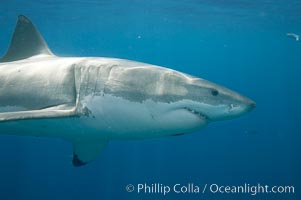
A great white shark is countershaded, with a dark gray dorsal color and light gray to white underside, making it more difficult for the shark's prey to see it as approaches from above or below in the water column. The particular undulations of the countershading line along its side, where gray meets white, is unique to each shark and helps researchers to identify individual sharks in capture-recapture studies. Guadalupe Island is host to a relatively large population of great white sharks who, through a history of video and photographs showing their countershading lines, are the subject of an ongoing study of shark behaviour, migration and population size.
Species: Great white shark, Carcharodon carcharias
Location: Guadalupe Island (Isla Guadalupe), Baja California, Mexico
Image ID: 19474
Species: Great white shark, Carcharodon carcharias
Location: Guadalupe Island (Isla Guadalupe), Baja California, Mexico
Image ID: 19474
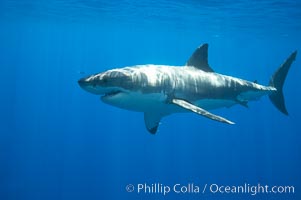
A great white shark is countershaded, with a dark gray dorsal color and light gray to white underside, making it more difficult for the shark's prey to see it as approaches from above or below in the water column. The particular undulations of the countershading line along its side, where gray meets white, is unique to each shark and helps researchers to identify individual sharks in capture-recapture studies. Guadalupe Island is host to a relatively large population of great white sharks who, through a history of video and photographs showing their countershading lines, are the subject of an ongoing study of shark behaviour, migration and population size.
Species: Great white shark, Carcharodon carcharias
Location: Guadalupe Island (Isla Guadalupe), Baja California, Mexico
Image ID: 19481
Species: Great white shark, Carcharodon carcharias
Location: Guadalupe Island (Isla Guadalupe), Baja California, Mexico
Image ID: 19481
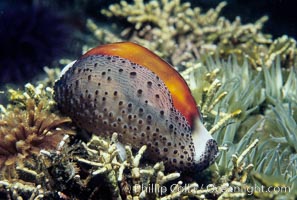
Chestnut cowrie with mantle extended, feather duster worm.
Species: Chestnut cowrie, Date cowrie, Cypraea spadicea, Eudistylia polymorpha
Location: Santa Cruz Island, California
Image ID: 01061
Species: Chestnut cowrie, Date cowrie, Cypraea spadicea, Eudistylia polymorpha
Location: Santa Cruz Island, California
Image ID: 01061
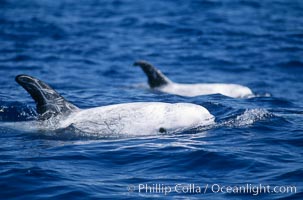
Rissos dolphin surfacing with eye showing. Note distinguishing and highly variable skin and dorsal fin patterns, characteristic of this species. White scarring, likely caused by other Risso dolphins teeth, accumulates during the dolphins life so that adult Rissos dolphins are almost entirely white. San Diego.
Species: Risso's dolphin, Grampus griseus
Location: San Diego, California
Image ID: 02314
Species: Risso's dolphin, Grampus griseus
Location: San Diego, California
Image ID: 02314
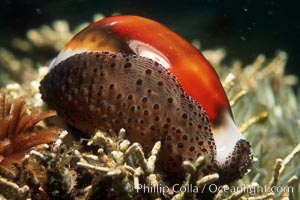
Chestnut cowry, mantle exposed.
Species: Chestnut cowrie, Date cowrie, Cypraea spadicea
Location: San Miguel Island, California
Image ID: 00624
Species: Chestnut cowrie, Date cowrie, Cypraea spadicea
Location: San Miguel Island, California
Image ID: 00624
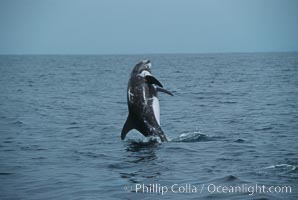
Rissos dolphin, breaching. Note distinguishing and highly variable skin and dorsal fin patterns, characteristic of this species. White scarring, likely caused by other Risso dolphins teeth, accumulates during the dolphins life so that adult Rissos dolphins are almost entirely white. San Diego.
Species: Risso's dolphin, Grampus griseus
Location: San Diego, California
Image ID: 00983
Species: Risso's dolphin, Grampus griseus
Location: San Diego, California
Image ID: 00983
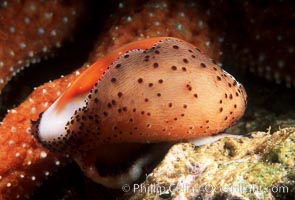
Chestnut cowrie with mantle extended.
Species: Chestnut cowrie, Date cowrie, Cypraea spadicea
Location: San Miguel Island, California
Image ID: 01062
Species: Chestnut cowrie, Date cowrie, Cypraea spadicea
Location: San Miguel Island, California
Image ID: 01062
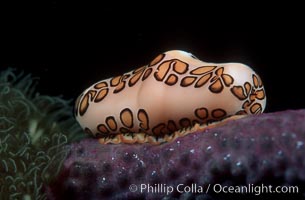
Flamingo tongue snail.
Species: Flamingo tongue cowrie, Cyphoma gibbosum
Location: Roatan, Honduras
Image ID: 02554
Species: Flamingo tongue cowrie, Cyphoma gibbosum
Location: Roatan, Honduras
Image ID: 02554
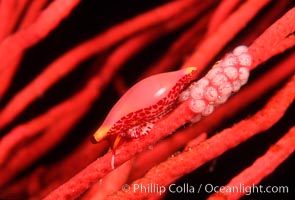
Simnia and egg cluster on gorgonian.
Species: Simnia, Delonovolva aequalis
Location: Anacapa Island, California
Image ID: 02556
Species: Simnia, Delonovolva aequalis
Location: Anacapa Island, California
Image ID: 02556
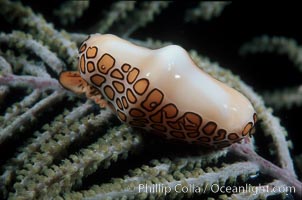
Flamingo tongue snail.
Species: Flamingo tongue cowrie, Cyphoma gibbosum
Location: Roatan, Honduras
Image ID: 02567
Species: Flamingo tongue cowrie, Cyphoma gibbosum
Location: Roatan, Honduras
Image ID: 02567
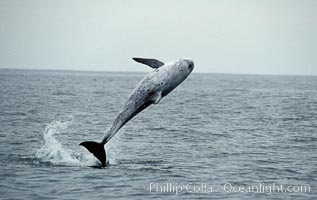
A Rissos dolphin leaps from the ocean in a full breach. Note distinguishing and highly variable skin and dorsal fin patterns, characteristic of this species. White scarring, likely caused by other Risso dolphins teeth, accumulates during the dolphins life so that adult Rissos dolphins are almost entirely white. Offshore near San Diego.
Species: Risso's dolphin, Grampus griseus
Location: San Diego, California
Image ID: 07597
Species: Risso's dolphin, Grampus griseus
Location: San Diego, California
Image ID: 07597
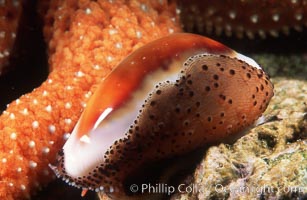
Chestnut cowrie with mantle extended.
Species: Chestnut cowrie, Date cowrie, Cypraea spadicea
Location: San Miguel Island, California
Image ID: 01035
Species: Chestnut cowrie, Date cowrie, Cypraea spadicea
Location: San Miguel Island, California
Image ID: 01035
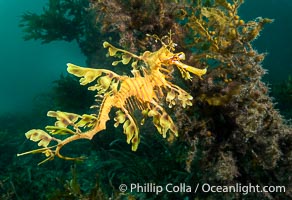
The leafy seadragon (Phycodurus eques) is found on the southern and western coasts of Australia. Its extravagent appendages serve only for camoflage, since it has a nearly-invisible dorsal fin that propels it slowly through the water. The leafy sea dragon is the marine emblem of South Australia.
Species: Leafy seadragon, Phycodurus eques
Location: Rapid Bay Jetty, South Australia
Image ID: 39132
Species: Leafy seadragon, Phycodurus eques
Location: Rapid Bay Jetty, South Australia
Image ID: 39132
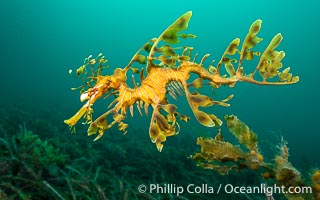
The leafy seadragon (Phycodurus eques) is found on the southern and western coasts of Australia. Its extravagent appendages serve only for camoflage, since it has a nearly-invisible dorsal fin that propels it slowly through the water. The leafy sea dragon is the marine emblem of South Australia.
Species: Leafy seadragon, Phycodurus eques
Location: Rapid Bay Jetty, South Australia
Image ID: 39135
Species: Leafy seadragon, Phycodurus eques
Location: Rapid Bay Jetty, South Australia
Image ID: 39135
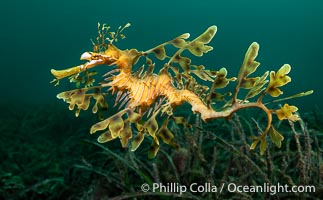
The leafy seadragon (Phycodurus eques) is found on the southern and western coasts of Australia. Its extravagent appendages serve only for camoflage, since it has a nearly-invisible dorsal fin that propels it slowly through the water. The leafy sea dragon is the marine emblem of South Australia.
Species: Leafy seadragon, Phycodurus eques
Location: Rapid Bay Jetty, South Australia
Image ID: 39138
Species: Leafy seadragon, Phycodurus eques
Location: Rapid Bay Jetty, South Australia
Image ID: 39138
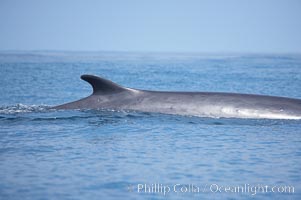
Fin whale dorsal fin. The fin whale is named for its tall, falcate dorsal fin. Mariners often refer to them as finback whales. Coronado Islands, Mexico (northern Baja California, near San Diego).
Species: Fin whale, Balaenoptera physalus
Location: Coronado Islands (Islas Coronado), Baja California, Mexico
Image ID: 12771
Species: Fin whale, Balaenoptera physalus
Location: Coronado Islands (Islas Coronado), Baja California, Mexico
Image ID: 12771
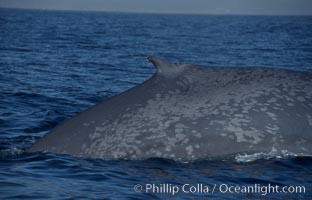
An enormous blue whale rounds out (hunches up its back) before diving. Note the distinctive mottled skin pattern and small, falcate dorsal fin. Open ocean offshore of San Diego.
Species: Blue whale, Balaenoptera musculus
Location: San Diego, California
Image ID: 07573
Species: Blue whale, Balaenoptera musculus
Location: San Diego, California
Image ID: 07573
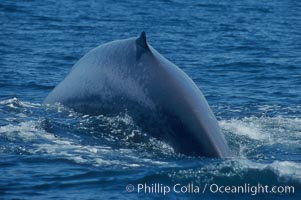
An enormous blue whale rounds out (hunches up its back) before diving. Note the distinctive mottled skin pattern and small, falcate dorsal fin. Open ocean offshore of San Diego.
Species: Blue whale, Balaenoptera musculus
Location: San Diego, California
Image ID: 07577
Species: Blue whale, Balaenoptera musculus
Location: San Diego, California
Image ID: 07577
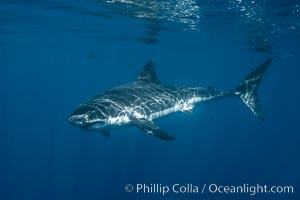
Great white shark, research identification photograph. A great white shark is countershaded, with a dark gray dorsal color and light gray to white underside, making it more difficult for the shark's prey to see it as approaches from above or below in the water column. The particular undulations of the countershading line along its side, where gray meets white, is unique to each shark and helps researchers to identify individual sharks in capture-recapture studies. Guadalupe Island is host to a relatively large population of great white sharks who, through a history of video and photographs showing their countershading lines, are the subject of an ongoing study of shark behaviour, migration and population size.
Species: Great white shark, Carcharodon carcharias
Location: Guadalupe Island (Isla Guadalupe), Baja California, Mexico
Image ID: 28768
Species: Great white shark, Carcharodon carcharias
Location: Guadalupe Island (Isla Guadalupe), Baja California, Mexico
Image ID: 28768
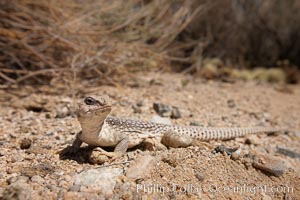
Desert iguana, one of the most common lizards of the Sonoran and Mojave deserts of the southwestern United States and northwestern Mexico.
Species: Northern desert iguana, Dipsosaurus dorsalis
Location: Joshua Tree National Park, California
Image ID: 26728
Species: Northern desert iguana, Dipsosaurus dorsalis
Location: Joshua Tree National Park, California
Image ID: 26728
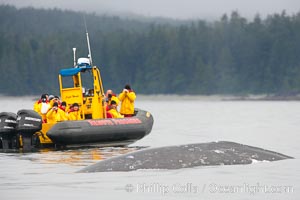
Gray whale dorsal ridge (back) at the surface in front of a boat full of whale watchers, Cow Bay, Flores Island, near Tofino, Clayoquot Sound, west coast of Vancouver Island.
Species: Gray whale, Eschrichtius robustus
Location: Cow Bay, Flores Island, British Columbia, Canada
Image ID: 21180
Species: Gray whale, Eschrichtius robustus
Location: Cow Bay, Flores Island, British Columbia, Canada
Image ID: 21180
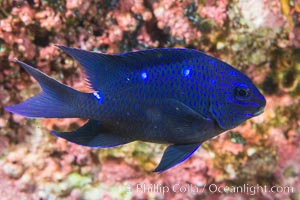
Giant damselfish juvenile, Sea of Cortez.
Location: Isla Las Animas, Baja California, Mexico
Image ID: 33687
Location: Isla Las Animas, Baja California, Mexico
Image ID: 33687
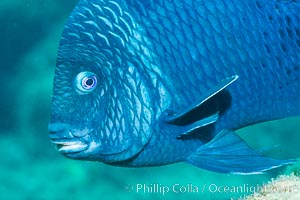
Giant damselfish, Sea of Cortez, Baja California, Mexico.
Location: Punta Alta, Baja California, Mexico
Image ID: 33733
Location: Punta Alta, Baja California, Mexico
Image ID: 33733
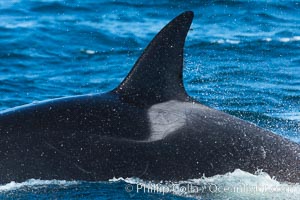
Saddle patch and dorsal fin of a killer whale, Palos Verdes.
Species: Killer whale, Orcinus orca
Location: Palos Verdes, California
Image ID: 30434
Species: Killer whale, Orcinus orca
Location: Palos Verdes, California
Image ID: 30434
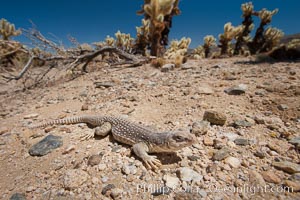
Desert iguana, one of the most common lizards of the Sonoran and Mojave deserts of the southwestern United States and northwestern Mexico.
Species: Northern desert iguana, Dipsosaurus dorsalis
Location: Joshua Tree National Park, California
Image ID: 26735
Species: Northern desert iguana, Dipsosaurus dorsalis
Location: Joshua Tree National Park, California
Image ID: 26735
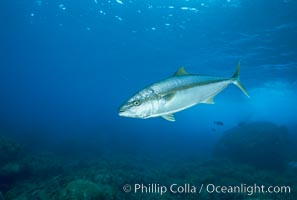
North Pacific Yellowtail at Guadalupe Island, Mexico.
Species: North Pacific Yellowtail, Seriola lalandi
Location: Guadalupe Island (Isla Guadalupe), Baja California, Mexico
Image ID: 05188
Species: North Pacific Yellowtail, Seriola lalandi
Location: Guadalupe Island (Isla Guadalupe), Baja California, Mexico
Image ID: 05188
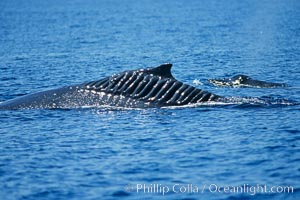
Blade Runner, the injured North Pacific humpback whale, is seen with her calf swimming alongside. This humpback whale showing extensive scarring, almost certainly from a boat propeller, on dorsal ridge. This female North Pacific humpback whale was first seen with the depicted lacerations near the island of Maui in the Hawaiian Islands in the mid-90s, and is the original humpback to bear the name 'Blade Runner'. This female has apparently recovered, as evidenced by her calf in the background. A South Pacific humpback whale endured a similar injury in Sydney Australia in 2001, and bears a remarkably similar scar pattern to the above-pictured whale.
Species: Humpback whale, Megaptera novaeangliae
Location: Maui, Hawaii
Image ID: 05907
Species: Humpback whale, Megaptera novaeangliae
Location: Maui, Hawaii
Image ID: 05907